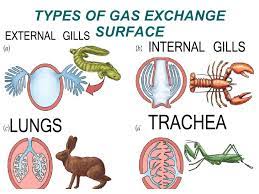Animals have evolved different organs for the uptake of oxygen from the environment and for getting rid of the carbon dioxide produced in the body during respiration.
Exchange of gasses in animals may occur through their skin or through specific respiratory organs.
These organs have structures that increase the surface area and are in contact with oxygen-rich atmosphere.
These organs work together and constitute the respiratory system of an organism.
Also Check- Importance Of Respiration
4 Important Factors for Efficient Gaseous Exchange in Respiratory System
For efficient gaseous exchange, the respiratory surface should be-
- Thin-walled
- Moist to speed up diffusions
- Large surface area
- Rich in blood supply

Also Check- Respiration in Plants
Respiration In Aquatic Organisms
- In aquatic organisms The rate of breathing is higher as compared to terrestrial organisms as these organisms utilize oxygen dissolved in water which is present in a lesser amount compared to others.
- The aquatic organisms breathe more rapidly to accumulate more and more oxygen.
- Fishes take in water through their mouth and force it to pass into the gills where the dissolved oxygen is taken up by blood flowing in blood vessels.
Also Check – Respiration in Human Beings
Respiration in Terrestrial Organisms
- Terrestrial organisms use atmospheric oxygen for respiration.
- This oxygen is absorbed by different organs in different animals.
- All these organs have a structure that increases their surface area and are present in contact with the oxygen rich atmosphere.
- The exchange of oxygen and carbon dioxide has to take place across this surface, the surface is very fine and delicate.
- To protect this surface, it is usually placed within the body well-protected, so there have to be numerous passages that will take air to this area.
- There is a mechanism for moving air in and out of this area where the oxygen is absorbed.


4 Comments on “Respiration in Animals – Class 10”